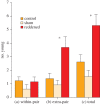Experimental evidence that extra-pair mating drives asymmetrical introgression of a sexual trait
- PMID: 24089341
- PMCID: PMC3790495
- DOI: 10.1098/rspb.2013.2175
Experimental evidence that extra-pair mating drives asymmetrical introgression of a sexual trait
Abstract
Theory suggests that traits under positive selection may introgress asymmetrically across a hybrid zone, potentially driven by sexual selection. Two subspecies of the red-backed fairy-wren (Malurus melanocephalus) differ primarily in a sexual signal used in mate choice-red versus orange male back plumage colour-but phylogeographic analyses suggest asymmetrical introgression of red plumage into the genetic background of the orange subspecies. We hypothesized that this asymmetrical introgression may be facilitated by sexual selection if red males have a mating advantage over orange males. We tested this hypothesis with correlational data and a plumage manipulation experiment where we reddened the back plumage of a subset of orange males to mimic males of the red subspecies. There was no correlational evidence of a mating advantage to naturally redder males in this population. Experimentally reddened males sired a similar amount of within-pair young and lost paternity at the same rate as orange males, but they sired significantly more extra-pair young, leading to substantially higher total reproductive success. Thus, we conclude that sexual selection via extra-pair mating is a likely mechanism responsible for the asymmetrical introgression of plumage colour in this system, and is potentially driven by a sensory bias for the red plumage signal.
Keywords: asymmetrical introgression; extra-pair mating; plumage colour; sensory bias; sexual selection; speciation.
Figures



References
-
- Irwin DE, Price TD. 1999. Sexual imprinting, learning and speciation. Heredity 82, 347–354 (doi:10.1038/sj.hdy.6885270) - DOI - PubMed
-
- Questiau S. 1999. How can sexual selection promote population divergence? Ethol. Ecol. Evol. 11, 313–324 (doi:10.1080/08927014.1999.9522816) - DOI
-
- Servedio MR, Saether SA, Saetre GP. 2007. Reinforcement and learning. Evol. Ecol. 23, 109–123 (doi:10.1007/s10682-007-9188-2) - DOI
-
- Kaneshiro KY. 1980. Sexual isolation, speciation and the direction of evolution. Evolution 34, 437–444 (doi:10.2307/2408213) - DOI - PubMed
-
- Arnold SJ, Verrell PA, Tilley SG. 1996. The evolution of asymmetry in sexual isolation: a model and a test case. Evolution 50, 1024–1033 (doi:10.2307/2410643) - DOI - PubMed
Publication types
MeSH terms
LinkOut - more resources
Full Text Sources
Other Literature Sources

